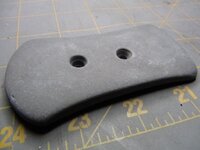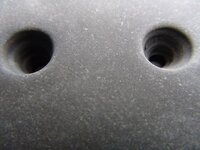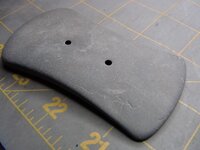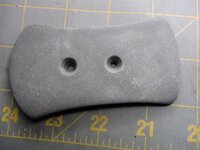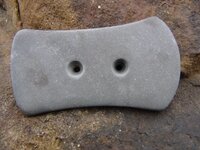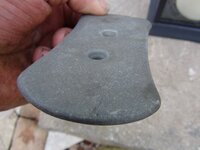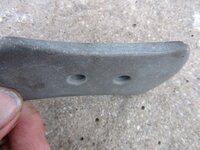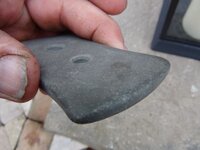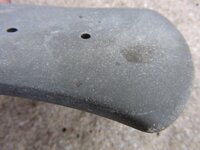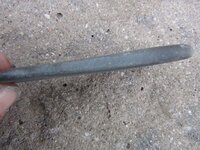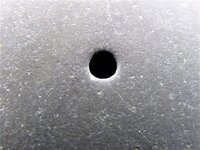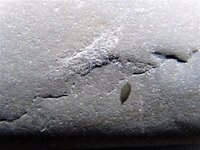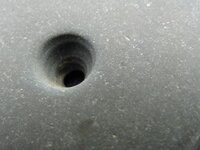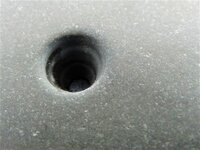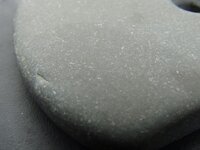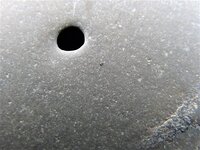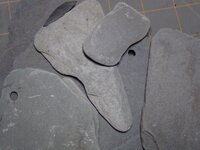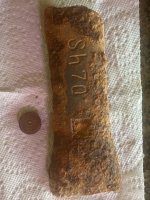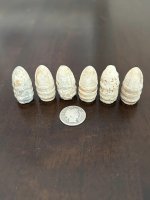You are using an out of date browser. It may not display this or other websites correctly.
You should upgrade or use an alternative browser.
You should upgrade or use an alternative browser.
✅ SOLVED Looks hand drilled to me. Any ideas?
- Thread starter Larryb
- Start date
joshuaream
Silver Member
I assume you are asking because you are questioning if that hole could be modern. If you found it, then yes it would be hand drilled.
Those holes can be made with a normal drill. Or many replicators will drill a small hole and the clean out the hole by drilling it with tapered flint (an old point or a knapped drill, or even a flake.). If you have a set of drill bits check them, carefully, against the holes. Those type of drill marks can be made by starting with a larger bit and then working toward smaller sizes. Often times the first ring and the opposite hole will match really well with common drill bit sizes.
Those holes can be made with a normal drill. Or many replicators will drill a small hole and the clean out the hole by drilling it with tapered flint (an old point or a knapped drill, or even a flake.). If you have a set of drill bits check them, carefully, against the holes. Those type of drill marks can be made by starting with a larger bit and then working toward smaller sizes. Often times the first ring and the opposite hole will match really well with common drill bit sizes.
Larryb
Jr. Member
- Dec 24, 2012
- 65
- 117
- Detector(s) used
- CTX3030
- Primary Interest:
- All Treasure Hunting
- Thread starter
- #5
It is a found piece. I hunt old glass along a river on a regular basis and happened to find this yesterday. It was found in a area that I find arrow heads fairly regular and is down stream from some large Indian mounds. Some in the regular "what is it" forum thing it is a gorget.
Larryb
Jr. Member
- Dec 24, 2012
- 65
- 117
- Detector(s) used
- CTX3030
- Primary Interest:
- All Treasure Hunting
- Thread starter
- #6
Sorry it seems off. It was not made by me but found by me while hunting old glass along a river. I've been hunting there for 9 years and have several nice arrow heads from there. I am just not a native american artifact expert and was hoping someone here might know what it is.
sandchip
Silver Member
- Oct 29, 2010
- 4,351
- 6,871
- Detector(s) used
- Teknetics T2SE
- Primary Interest:
- All Treasure Hunting
I don't see it being a plant, so I think you did good! I'd love to find something like that. Being in the water seems to have softened its features a little, but with that time in the creek, I would expect some degree of tannic staining.
And for what it's worth, it would be considered an Adena drilled hourglass gorget.
And for what it's worth, it would be considered an Adena drilled hourglass gorget.
Last edited:
Was the relic found along the bank of the river in an area which it would have been submerged? Or was it higher up on a rise along the river?
What state was this found in?
What is the material?
Can you post some images of this from above and from the sides showing the profile?
How did you clean the relic after you found it?
What state was this found in?
What is the material?
Can you post some images of this from above and from the sides showing the profile?
How did you clean the relic after you found it?
Larryb
Jr. Member
- Dec 24, 2012
- 65
- 117
- Detector(s) used
- CTX3030
- Primary Interest:
- All Treasure Hunting
- Thread starter
- #9
It would have been in a area that would have been under water part of the time. It was found in Ohio about 5 miles from the mound builders site. It looks to be slate. I did not clean it at all. I'll work on some more pics to post.
Last edited:
joshuaream
Silver Member
Congrats Larry, that’s a really nice find. You probably won’t top it anytime soon, but that’s a good problem to have.
joshuaream
Silver Member
... for what it's worth, it would be considered an Adena drilled hourglass gorget.
I’d go with Adena Bi-concave gorget, but that might be an Indiana/Ohio name for that style. Adena either way.
Larryb
Jr. Member
- Dec 24, 2012
- 65
- 117
- Detector(s) used
- CTX3030
- Primary Interest:
- All Treasure Hunting
- Thread starter
- #13
This pic was taken a few min after I found it.
View attachment 1517697
View attachment 1517697
Authenticity is virtually impossible to determine from photographs.
You stating you found it is good proof of authenticity.
Some sites have been known to be salted in an attempt to fool or have items recently made brought into the collector world as authentic.
This item is not the classic shape of a Bi-concave gorget. To be submerged in water for how many years it should have been, one would expect to find evidence of submersion such as discoloration or build up of minerals. Slate is porous and the water over the years would have impregnated the material in different amounts depending on the minerals in the water and the density of the material.
During manufacture, after pecking to the desired shape, the holes are drilled and then polishing takes place. Often some peck marks are still visible even on relics with a very good polish. Look for peck marks on the relic with a loupe.
The holes on those I have found, pendants and gorgets, mostly then have a sharper edge around the holes with often wear and more smoothing in the are where the leather string would have worn against the material over time.
Some of the slate relics I have seen from Ohio have different holes configuration than many found in Indiana.
Using a loupe, look for mineral deposits and try to post close up photos of any found please.
You stating you found it is good proof of authenticity.
Some sites have been known to be salted in an attempt to fool or have items recently made brought into the collector world as authentic.
This item is not the classic shape of a Bi-concave gorget. To be submerged in water for how many years it should have been, one would expect to find evidence of submersion such as discoloration or build up of minerals. Slate is porous and the water over the years would have impregnated the material in different amounts depending on the minerals in the water and the density of the material.
During manufacture, after pecking to the desired shape, the holes are drilled and then polishing takes place. Often some peck marks are still visible even on relics with a very good polish. Look for peck marks on the relic with a loupe.
The holes on those I have found, pendants and gorgets, mostly then have a sharper edge around the holes with often wear and more smoothing in the are where the leather string would have worn against the material over time.
Some of the slate relics I have seen from Ohio have different holes configuration than many found in Indiana.
Using a loupe, look for mineral deposits and try to post close up photos of any found please.
Larryb
Jr. Member
- Dec 24, 2012
- 65
- 117
- Detector(s) used
- CTX3030
- Primary Interest:
- All Treasure Hunting
- Thread starter
- #17
After looking at the slate pieces we pick up here for craft making, I would say that it looks exactly like a natural slate stone that has been there for ever. The holes in it are what made me look twice at it and pick it up. As you can see in the pick of the natural stones we collected. These were not washed after collection ether.
Thanks for extra pics. Sounds and looks like a winner. My biggest concern was lack of stain but these examples show some consistency of what’s in the area. I would be extremely excited by the find. Thanks for sharing.
monsterrack
Silver Member
- Apr 15, 2013
- 4,419
- 5,815
- Detector(s) used
- Garrett, and Whites
- Primary Interest:
- All Treasure Hunting
The holes look good to me modern drills will leave a very tight pattern in the rings, when flint leaves a larger finger print in the rings. One way to check is to get a scope or strong eye glass and look to make sure both holes are not just a like, because this didn't happen when done by hand. Very nice find.
NCPeaches
Silver Member
That's an awesome find and on my bucket list to find in my creek someday! It would make my day to find one of those, you did good!
Top Member Reactions
-
 2389
2389 -
 1139
1139 -
 1095
1095 -
 896
896 -
 827
827 -
 803
803 -
 766
766 -
 738
738 -
 619
619 -
 505
505 -
 493
493 -
 474
474 -
 468
468 -
 426
426 -
 399
399 -
 392
392 -
O
372
-
 367
367 -
 365
365 -
 362
362
Users who are viewing this thread
Total: 2 (members: 0, guests: 2)
